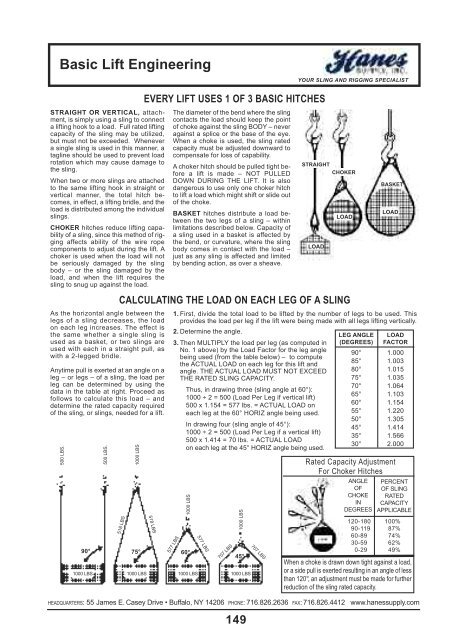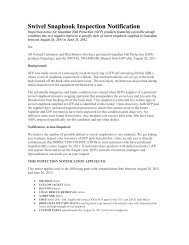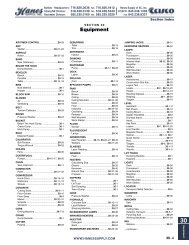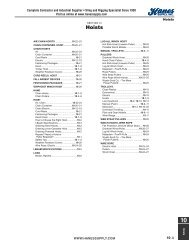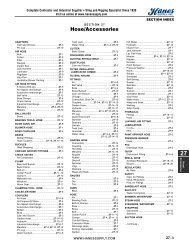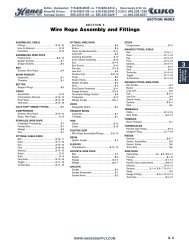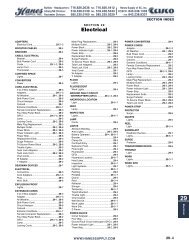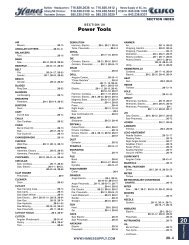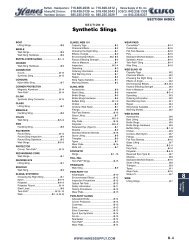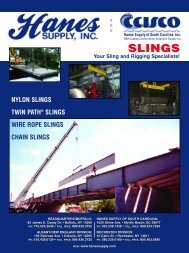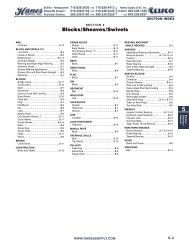twin-path® slings in action - Hanes Supply, Inc
twin-path® slings in action - Hanes Supply, Inc
twin-path® slings in action - Hanes Supply, Inc
- No tags were found...
Create successful ePaper yourself
Turn your PDF publications into a flip-book with our unique Google optimized e-Paper software.
asic lift eng<strong>in</strong>eer<strong>in</strong>gYOUR SLING AND RIGGING SPECIALISTstRaIGHt oR VeRtIcal, attachment,is simply us<strong>in</strong>g a sl<strong>in</strong>g to connecta lift<strong>in</strong>g hook to a load. Full rated lift<strong>in</strong>gcapacity of the sl<strong>in</strong>g may be utilized,but must not be exceeded. Whenevera s<strong>in</strong>gle sl<strong>in</strong>g is used <strong>in</strong> this manner, atagl<strong>in</strong>e should be used to prevent loadrotation which may cause damage tothe sl<strong>in</strong>g.When two or more <strong>sl<strong>in</strong>gs</strong> are attachedto the same lift<strong>in</strong>g hook <strong>in</strong> straight orvertical manner, the total hitch becomes,<strong>in</strong> effect, a lift<strong>in</strong>g bridle, and theload is distributed among the <strong>in</strong>dividual<strong>sl<strong>in</strong>gs</strong>.cHokeR hitches reduce lift<strong>in</strong>g capabilityof a sl<strong>in</strong>g, s<strong>in</strong>ce this method of rigg<strong>in</strong>gaffects ability of the wire ropecomponents to adjust dur<strong>in</strong>g the lift. Achoker is used when the load will notbe seriously damaged by the sl<strong>in</strong>gbody – or the sl<strong>in</strong>g damaged by theload, and when the lift requires thesl<strong>in</strong>g to snug up aga<strong>in</strong>st the load.As the horizontal angle between thelegs of a sl<strong>in</strong>g decreases, the loadon each leg <strong>in</strong>creases. The effect isthe same whether a s<strong>in</strong>gle sl<strong>in</strong>g isused as a basket, or two <strong>sl<strong>in</strong>gs</strong> areused with each <strong>in</strong> a straight pull, aswith a 2-legged bridle.Anytime pull is exerted at an angle on aleg – or legs – of a sl<strong>in</strong>g, the load perleg can be determ<strong>in</strong>ed by us<strong>in</strong>g thedata <strong>in</strong> the table at right. Proceed asfollows to calculate this load – anddeterm<strong>in</strong>e the rated capacity requiredof the sl<strong>in</strong>g, or <strong>sl<strong>in</strong>gs</strong>, needed for a lift.500 LBS.1000 LBS500 LBS.518 LBSEVERY LIFT USES 1 OF 3 BASIC HITCHESThe diameter of the bend where the sl<strong>in</strong>gcontacts the load should keep the po<strong>in</strong>tof choke aga<strong>in</strong>st the sl<strong>in</strong>g BODY – neveraga<strong>in</strong>st a splice or the base of the eye.When a choke is used, the sl<strong>in</strong>g ratedcapacity must be adjusted downward tocompensate for loss of capability.A choker hitch should be pulled tight beforea lift is made – NOT PULLEDDOWN DURING THE LIFT. It is alsodangerous to use only one choker hitchto lift a load which might shift or slide outof the choke.basket hitches distribute a load betweenthe two legs of a sl<strong>in</strong>g – with<strong>in</strong>limitations described below. Capacity ofa sl<strong>in</strong>g used <strong>in</strong> a basket is affected bythe bend, or curvature, where the sl<strong>in</strong>gbody comes <strong>in</strong> contact with the load –just as any sl<strong>in</strong>g is affected and limitedby bend<strong>in</strong>g <strong>action</strong>, as over a sheave.CALCULATING THE LOAD ON EACH LEG OF A SLING1000 LBS1. First, divide the total load to be lifted by the number of legs to be used. Thisprovides the load per leg if the lift were be<strong>in</strong>g made with all legs lift<strong>in</strong>g vertically.2. Determ<strong>in</strong>e the angle.leG anGle loaD3. Then MULTIPLY the load per leg (as computed <strong>in</strong>No. 1 above) by the Load Factor for the leg anglebe<strong>in</strong>g used (from the table below) – to computethe ACTUAL LOAD on each leg for this lift andangle. THE ACTUAL LOAD MUST NOT EXCEEDTHE RATED SLING CAPACITY.Thus, <strong>in</strong> draw<strong>in</strong>g three (sl<strong>in</strong>g angle at 60°):1000 ÷ 2 = 500 (Load Per Leg if vertical lift)500 x 1.154 = 577 lbs. = ACTUAL LOAD oneach leg at the 60° HORIZ angle be<strong>in</strong>g used.In draw<strong>in</strong>g four (sl<strong>in</strong>g angle of 45°):1000 ÷ 2 = 500 (Load Per Leg if a vertical lift)500 x 1.414 = 70 lbs. = ACTUAL LOADon each leg at the 45° HORIZ angle be<strong>in</strong>g used.1000 LBS90° 75° 60°518 LBS577 LBS577 LBS707 LBS1000 LBS 1000 LBS 1000 LBSHEADQUARTERS: 55 James E. Casey Drive • Buffalo, NY 14206 PHONE: 716.826.2636 FAX: 716.826.4412 www.hanessupply.com1000 LBS45°149707 LBSstRaIGHtcHokeRloaDloaDbasketloaD(DeGRees) factoR90° 1.00085° 1.00380° 1.01575° 1.03570° 1.06465° 1.10360° 1.15455° 1.22050° 1.30545° 1.41435° 1.56630° 2.000Rated Capacity AdjustmentFor Choker HitchesANGLE PERCENTOF OF SLINGCHOKE RATEDIN CAPACITYDEGREES APPLICABLE120-18090-11960-8930-590-29100%87%74%62%49%When a choke is drawn down tight aga<strong>in</strong>st a load,or a side pull is exerted result<strong>in</strong>g <strong>in</strong> an angle of lessthan 120°, an adjustment must be made for furtherreduction of the sl<strong>in</strong>g rated capacity.


